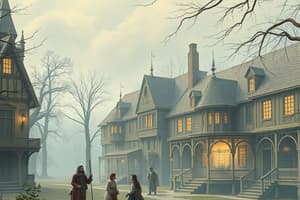Podcast
Questions and Answers
What are some of the problems affecting the forests in the state according to the passage?
What are some of the problems affecting the forests in the state according to the passage?
According to the passage, some of the problems affecting the forests in the state include: insects, diseases, and poor harvesting practices that are driving tree species composition change, leading to less desirable tree species becoming more common, invasive exotic plants outcompeting native trees and plants, and competing native plants like ferns, spicebush, and mountain laurel increasing in the forest understories.
What is happening to the oak species in the forests?
What is happening to the oak species in the forests?
The passage states that all of the oak species are much less common in the forests.
What are some examples of the invasive exotic plants that are competing with native trees and plants?
What are some examples of the invasive exotic plants that are competing with native trees and plants?
The passage provides examples of invasive exotic plants such as multiflora rose, bush honeysuckle, ailanthus (aka, tree of heaven), autumn olive, and garlic mustard.
What are some of the negative effects of the poorly conceived harvesting practices described in the passage?
What are some of the negative effects of the poorly conceived harvesting practices described in the passage?
What is needed to restore forest health and provide future value to landowners?
What is needed to restore forest health and provide future value to landowners?
What are some of the less desirable tree species that are becoming more common in the forests?
What are some of the less desirable tree species that are becoming more common in the forests?
When was the first sawmill established in Pennsylvania?
When was the first sawmill established in Pennsylvania?
What percentage of Pennsylvania was covered by forests when it was given to William Penn in 1681?
What percentage of Pennsylvania was covered by forests when it was given to William Penn in 1681?
What did Penn recommend regarding the clearing of forests?
What did Penn recommend regarding the clearing of forests?
What was the peak of land clearing in Pennsylvania?
What was the peak of land clearing in Pennsylvania?
What happened to the forest-dependent industries during the period of forest exploitation?
What happened to the forest-dependent industries during the period of forest exploitation?
How does the current state of Pennsylvania's forests compare to the past?
How does the current state of Pennsylvania's forests compare to the past?
Flashcards are hidden until you start studying




